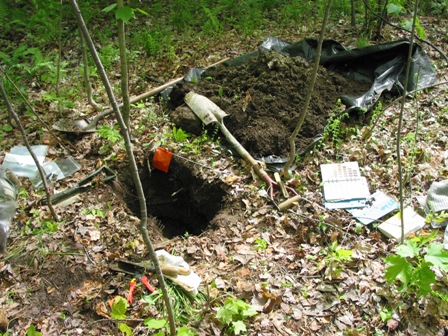
in Managed Northern Forests
Plot Design
One plot consisted of:
- six soil subplots at 90 feet from the center of the plot, every 60 degrees (three additional subplots than the FIA protocol, depicted on the image on the right). Pits were only sampled at soil subplots 1, 3, and 5. Cores were sampled at each soil subplots.
- four vegetation subplots, one at the center of the plot, the three others every 120 degrees (grey circles on the image). Each vegetation subplots has a radius of 24 feet.

A yellow stake was pounded in the ground at the center of the plot as permanent marker.
Plot Design | Measuring Soil Carbon | Calculating Soil Carbon
Measuring Above Ground Carbon | Calculating Above Ground Carbon
Measuring Soil Carbon

Soil horizons can be differentiated through a change in color or texture, a change in the abundance of roots, the presence or absence of redoxomorphic features, etc. For example in the picture on the right, an E horizon (grey color) and a Bs horizon (reddish color), can very easily be identified.
The amount of carbon can vary strikingly between horizons and it is therefore necessary to sample soils by horizons when quantifying soil carbon. Soil samples were collected from each soil horizon and analyzed in the lab.
Organic soil samples were analyzed in the lab. As the forest floor was collected over a known area, carbon per hectare (or acre) can easily be quantified.

To measure and calculate bulk density, we used a power auger equipped with a diamond-tipped core. We then collected cores of known depth (usually 10-20 cm) at each of the 6 soil subplots.
Cores were collected down to bedrock, water, or 100 cm depth, whichever came first. Soil samples obtained from cores were also analyzed in the lab.
The picture on the right illustrates how the power auger cored through a rock, allowing us to collect both the rock and soil sample.
- Bulk density was calculated for each mineral soil horizon using data obtained from cores sampled next to the soil pits:
- Percent carbon and nitrogen by soil dry weight were measured on a Thermo Scientific Flash EA 1112 Nitrogen and Carbon Analyzer for Soils, Sediments and Filters
- Carbon Pool in Mineral Soil (Mg/ha):
- Carbon Pool in Organic Soil (Mg/ha):
Measuring Above Ground Carbon | Calculating Above Ground Carbon
Each vegetation subplot contained a microplot where the percent ground cover occupied by moss, lichen, shrubs, etc. was estimated.
Saplings and seedlings were counted in each microplot.
To estimate the quantity of carbon stored in down woody material, we measured down trees and branches following the FIA protocol.
- Above-ground biomass (live trees):
bm = total aboveground biomass (kg dry mass)
DBH = diameter at breast height (cm)
Exp = exponential function
ln = log base e
For more details, see: Jenkins J.C., Chojnacky D.C., Heath L.S., and Birdsey R.A., National-Scale Biomass Estimators for United States Tree Species, Forest Science, Vol 49, No.1, February 2003
- Carbon stored in above-ground live trees:
- Down Woody Material, dead standing trees, and ground cover: coming soon
Measuring Above Ground Carbon | Calculating Above Ground Carbon